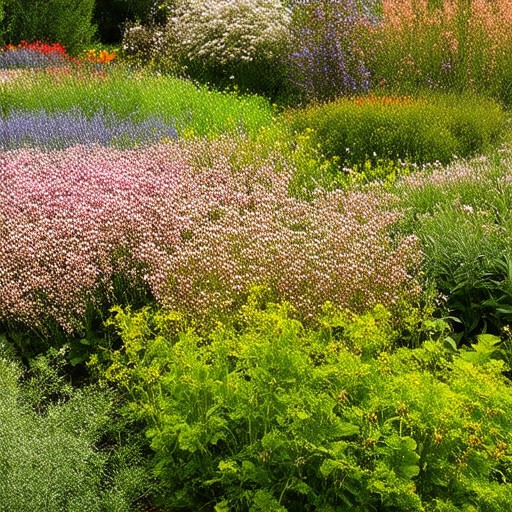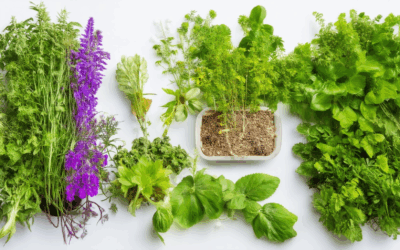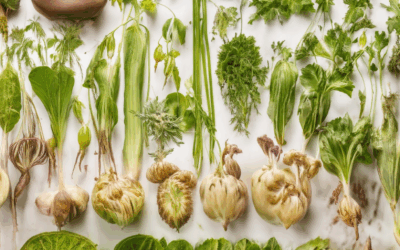Cooking with fresh herbs transforms simple dishes into flavorful masterpieces, offering a vibrant burst of aroma and taste. Among the many varieties available, heirloom herbs stand out as a unique and valuable addition to any kitchen. These heritage plants, passed down through generations, boast rich histories, diverse flavors, and unique health benefits, making them a cornerstone of culinary exploration. Whether you’re a seasoned cook or new to the world of herbs, heirloom herbs for cooking offer a gateway to unlocking endless possibilities in your meals.
Key Takeaways
– Annual Herbs for Flavorful Cooking: Enhance your cooking with annual herbs like Basil, Cilantro, and Dill, which add distinctive flavors to a variety of dishes.
– Perennial Herbs for Year-Round Use: Discover the benefits of Perennial Herbs like Rosemary and Thyme, which thrive in diverse conditions and provide long-lasting culinary value.
– Year-Round Availability: Enjoy fresh herbs such as Oregano, Thyme, and Cilantro, available throughout the year for versatile cooking applications.
What is an heirloom herb?
An heirloom herb is a variety of herb that has been passed down through generations, often dating back several centuries. These herbs are cherished for their unique traits, hardiness, and distinctive flavors. Heirloom herbs are typically open-pollinated, meaning they can reproduce naturally without human intervention, making them valuable for sustainable gardening practices.
Why Choose Heirloom Herbs?
-
Unique Flavors:
Heirloom herbs offer rich, complex flavors that modern hybrids often lack. Their taste and aroma are deeply rooted in tradition.
-
Natural Resistance:
Many heirloom varieties are naturally resistant to pests and diseases, reducing the need for synthetic chemicals.
-
Cultural Significance:
These herbs hold cultural and historical importance, often tied to regional traditions and culinary practices.
Benefits of Growing Heirloom Herbs
- Sustainability: Heirloom herbs are self-reliant, making them ideal for permaculture and organic gardening.
- Diverse Uses: They can be used in cooking, herbal remedies, and natural beauty products.
- Preservation of Biodiversity: By growing heirlooms, you contribute to the conservation of plant diversity.
Considerations for Growing Heirlooms
- Adaptability: Heirloom herbs may require specific conditions, such as full sun or regular watering.
- Seed Selection: Source seeds from reputable suppliers to ensure authenticity and viability.
Explore our collection of heirloom herb seeds and discover the joy of growing these timeless plants. Visit Old Seed to learn more about sustainable gardening and preserving these precious varieties.
Best Fresh Herbs for Cooking
When it comes to enhancing your cooking, fresh herbs add a vibrant flavor and aroma that canned or dried herbs simply can’t match. Here’s a curated list of the best fresh herbs to keep on hand:
- Basil – A versatile herb with a sweet, slightly peppery taste, perfect for Italian dishes, tomato-based sauces, and fresh salads.
- Thai Basil – A fragrant variety with a stronger citrus note, ideal for Asian cuisine, stir-fries, and spicy dishes.
- Rosemary – A woody herb with a pine-like fragrance, excellent for roasted meats, potatoes, and stews.
- Thyme – A Mediterranean herb with a earthy flavor, great for soups, stuffing, and grilled meats.
- Dill Weed – A pungent herb often used in Scandinavian and German cuisines, perfect for pickles, fish, and cream cheese spreads.
- Sage – A strong, aromatic herb with a slightly fruity undertone, commonly used in Thanksgiving stuffing and Italian dishes.
- Cilantro – A fresh, tangy herb with a lime-like zest, essential for salsas, guacamole, and Mexican dishes.
- Parsley – A versatile herb with a bright, grassy flavor, perfect for garnishing dishes or adding to stocks and soups.
- Chives – A delicate herb with a mild onion-like smell, great for garnishes, dips, and as a finishing touch for eggs.
- Oregano – A robust, spicy herb with a complex flavor profile, suitable for pizzas, pasta sauces, and marinades.
- Lemon Thyme – Combines the brightness of lemon with the earthiness of thyme, perfect for grilled chicken or seafood.
- Mint – A refreshing herb with a cool menthol flavor, great for tea, lamb dishes, and fresh salads.
- Fennel – Aniseedy herb with a licorice-like taste, often used in Italian and Middle Eastern cuisines.
- Bay Leaves – A aromatic herb with a sweet, woodsy scent, commonly used in stocks, soups, and stews.
For more tips on growing and maintaining these herbs, visit our herb gardening guide .
What is a Bouquet of Herbs for Cooking?
A bouquet of herbs, often referred to as a bouquet garni, is a collection of fresh herbs bundled together in a cloth or cheesecloth. This method allows for easy removal of the herbs while adding flavorful complexity to soups, stews, and sauces. Common herbs used in a bouquet garni include:
- Thyme
- Rosemary
- Bay leaf
- Parsley
- Mint
- Marjoram
- Oregano
- Sage
To prepare a bouquet garni, simply tie the selected herbs together with kitchen twine or place them in a small piece of cheesecloth. This method ensures that the flavors are evenly distributed throughout the dish without altering the texture. Bouquets garni are particularly popular in French cuisine and can elevate a variety of recipes, from slow-cooked meats to vegetable-based dishes.
Annual Herbs for Cooking
- Basil: A fragrant annual herb commonly used in Italian and Mediterranean cuisine. It adds a sweet, slightly peppery flavor to dishes.
- Cilantro: Known for its fresh, citrusy taste, cilantro is a popular annual herb used extensively in Mexican, Asian, and Middle Eastern cooking.
- Dill: A versatile annual herb with a tangy, slightly bitter flavor, perfect for enhancing the taste of pickles, fish, and cream sauces.
- Fennel: An aromatic annual herb with a licorice-like flavor, fennel is often used in Italian and European dishes, particularly in soups and stews.
- Parsley: A bright, grassy-flavored annual herb that adds a refreshing note to dishes like salads, pasta, and fish recipes.
- Rosemary: A strong, pine-scented annual herb that pairs well with roasted meats, vegetables, and bread dishes.
- Thyme: A woody annual herb with a earthy aroma, thyme is a staple in Mediterranean cuisine and works well in soups and stuffing.
- Oregano: A potent annual herb with a complex flavor profile, oregano is a favorite in Italian cooking and adds depth to pizzas and tomato-based sauces.
- Marjoram: A sweet, slightly spicy annual herb that enhances the flavor of dishes like lamb, veal, and egg dishes.
- Chives: A delicate annual herb with a mild onion-like flavor, chives are great for garnishing soups, salads, and baked goods.
- Bay Leaves: Though technically annual in warmer climates, bay leaves are often treated as annuals due to their growth habit. They add a subtle, aromatic depth to stocks, soups, and meat dishes.
Best Perennial Herbs
Perennial herbs are a fantastic addition to any garden, offering continuous beauty and culinary use throughout the year. Here are some of the best options:
- Rosemary – A favorite herb for seasoning, rosemary is a hardy perennial that thrives in Mediterranean climates. It grows well in full sun and requires little water once established.
- Thyme – Known for its drought tolerance, thyme is perfect for xeriscaping. It’s commonly used in culinary dishes and herbal teas.
- Oregano – A potent herb with medicinal properties, oregano adds flavor to meals and supports health when consumed in small amounts.
- Lavender – Not only beautiful, lavender is aromatic and has numerous uses, including relaxation and healing.
- Basil – A fragrant annual herb often considered a perennial in warmer climates, basil is essential for Italian cuisine and grows quickly in sunny conditions.
- Mint – While technically a perennial, mint spreads rapidly, so it’s best kept in containers. It’s versatile in cooking and offers fresh flavors year-round.
- Parsley – A versatile herb with a crisp flavor, parsley adds zest to dishes and can be grown indoors or in cooler climates.
- Cilantro – A staple in Mexican cuisine, cilantro is an annual herb that can be treated as a perennial in warmer regions.
- Dill – A fast-growing herb, dill is excellent for pickling and adding flavor to fish dishes. It prefers full sun and moist soil.
- Fennel – Similar to dill, fennel is a bulbous herb with a licorice-like taste. It’s great for cooking and attracts pollinators.
- Chamomile – Often used in tea, chamomile is a soothing herb that grows well in most climates and can be dried for year-round use.
These herbs not only enhance your garden’s beauty but also provide lasting value through their culinary and medicinal benefits. For more tips on growing these herbs and discovering additional varieties, visit our perennial herbs guide .
Herbs In Season All Year Round
Discover the best herbs that are available year-round, perfect for adding flavor to your dishes anytime:
- Basil – A versatile herb that stays fresh throughout the year, ideal for Italian and Mediterranean cuisine.
- Parsley – A staple in many kitchens, known for its fresh flavor and availability in both curly and flat leaf varieties.
- Cilantro – Adds a unique citrusy taste to dishes like tacos and salsas, easily found fresh year-round.
- Oregano – A popular spice made from wild or cultivated oregano, offering a robust flavor in pizzas and salads.
- Thyme – A fragrant herb that complements grilled meats and vegetables, often grown in gardens.
- Rosemary – A woody herb with a pine-like aroma, perfect for roasted vegetables and bread dipping.
- Mint – Available fresh or dried, it’s great for teas, cocktails, and freshening breath.
- Lemon Balm – A soothing herb used in teas and herbal remedies, known for its calming properties.
- Dill – A pungent herb often used in pickling and as a finishing touch for fish dishes.
- Fenugreek – A lesser-known herb with a maple-like flavor, used in Middle Eastern and Indian cuisines.
- Sage – A earthy herb that pairs well with sausage and egg dishes, also used in stuffing.
- Turmeric Root – Known for its vibrant yellow color and health benefits, often used in curries and soups.
- Lemongrass – A tropical herb with a citrusy scent, used in Asian soups and marinades.
- Cumin – A spicy herb with a nutty flavor, essential in Mexican and North African cooking.
- Coriander – A versatile herb that’s equally at home in Mexican and Mediterranean dishes.
- Ginger – A rhizome available fresh or powdered, adding warmth to Asian and Western recipes.
- Lavender – Not just for perfumes, it’s used in cooking for a floral touch and relaxation.
- Marrowfat – A type of seaweed used in Irish cuisine and as a nutrient-rich additive.
- Kaffir Lime Leaves – Adds a tangy flavor to Thai dishes and cocktails, sourced from the Kaffir lime tree.
- Nutmeg – A sweet and spicy herb used in both baking and beverages like eggnog.
- Cardamom – A complex spice with a warm, aromatic flavor, key in curries and breads.
- Celery Seeds – A peppery herb used in spice blends and as a garnish.
- Chives – A delicate herb with a mild onion flavor, perfect for garnishing soups and dips.
- Garlic – A staple in nearly every kitchen, known for its health benefits and versatility.
- Green Onions – Fresh chives bound together, used in salsas and toppings.
- Red Onions – Sweet and bold, a favorite in salads, burgers, and stir-fries.
- Yellow Onions – Rich and slightly sweet, ideal for caramelization in dishes.
- Shallots – A member of the onion family with a subtle, sweet flavor.
- Horseradish – A spicy root used in sauces and as a condiment for sandwiches.
- Mustard – Available in whole seed, powder, or paste forms, used in dressings and marinades.
- Sunflower Seeds – Used in spreads, snacks, and as a topping for salads.
- Pepitas – Roasted pumpkin seeds, a healthy snack and ingredient in dishes.
- Sesame Seeds – Tiny seeds with a nutty flavor, used in Asian and Middle Eastern cooking.
- Flaxseeds – Often ground into flours or used as meal additives for nutrition.
- Alfalfa Sprouts – Nutritious and crunchy, used in salads and sandwich toppings.
- Radishes – Quick-growing roots available year-round, perfect for raw snacking or cooking.
- Beetroot – A colorful root vegetable used in salads and as a nutritious addition.
- Carrots – Sweet and crunchy, a staple in soups, stir-fries, and snacks.
- Turnips – Similar to carrots, they add a mild flavor to dishes like mashed or fried.
- Kohlrabi – A bulbous vegetable with a crisp texture, used in salads and soups.
- Jicama – A root vegetable with a refreshing crunch, often used in Latin American cuisine.
- Bell Peppers – Available in red, yellow, and green, they add vibrant color to meals.
- Cucumber – Refreshing and hydrating, perfect for salads, sandwiches, and pickles.
- Zucchini – A versatile squash that’s easy to grow and use in both raw and cooked dishes.
- Yellow Squash – Similar to zucchini, it has a slightly sweeter flavor.
- Butternut Squash – A hearty winter squash used in soups and side dishes.
- Acorn Squash – A type of winter squash with a nutty flavor, often stuffed.
- Spaghetti Squash – Unique in texture, it’s shreds resemble spaghetti.
- Winter Squash – Includes varieties like butternut, acorn, and spaghetti squash.
- Tomatoes – Available much of the year, used in sauces, salads, and cooking.
- Corn – A summer favorite, but can be preserved through freezing or canning.
- Peppers – As mentioned earlier, they add a spicy kick to various dishes.
- Avocados – While seasonal in some regions, they can be stored for extended periods.
- Mangoes – Tropical fruits that are in season during their respective growing months.
- Pineapples – Available year-round through importation, though peak season varies.
- Coconuts – While primarily tropical, they can be found dried or in juice form.
- Bananas – Available most of the year, though their peak season is in warmer climates.
- Oranges – A citrus fruit that’s in season during winter months.
- Grapes – A versatile fruit used in wines, juices, and as a snack.
- Apples – Available year-round through storage and importation.
- Pears – A fruit that pairs well with cheeses and preserves, available seasonally.
- Strawberries – Though seasonal in many places, they can be frozen or preserved.
- Blueberries – Available fresh during their season and can be frozen.
- Raspberries – Similar to blueberries, they can be enjoyed fresh or frozen.
- Blackberries – Another berry that’s best enjoyed fresh or preserved.
- Goji Berries – A superfood berry available dried and in supplements.
- Kiwi – A fuzzy fruit with a tart flavor, available year-round in some regions.
- Melon – A sweet fruit that’s refreshing and can be cubed for snacks.
- Guava – A tropical fruit that’s in season during its own time.
- Durian – Known for its strong odor, it’s available during its short season.
- Macadamia nuts – A tropical nut used in snacks and baking.
- Pecans – A nut that’s popular in Southern U.S. cuisine.
- Walnuts – A versatile nut used in baking and as a snack.
- Almonds – Available roasted, sliced, or as a nut butter.
- Pistachios – A sweet nut used in both savory and sweet dishes.
- Pinon Nuts – A traditional nut used in Spanish and Native American dishes.
- Seeds – Include chia, flax, and hemp seeds for nutrition and toppings.
- Olives – Available in various forms, from green to ripe, used in cooking.
- Lemons – A citrus fruit used extensively in cooking and cleaning.
- Limes – Similar to lemons, they’re used in marinades and drinks.
- Breadfruit – A tropical fruit that’s starchy and can be baked or fried.
- Jackfruit – A large fruit used in tropical cuisines and preserves.
- Dragon Fruit – A cactus fruit with a sweet, crunchy interior.
- Starfruit – A unique fruit with a star-shaped cross-section.
- Figues – A fruit used in jams, jellies, and as a sweet treat.
- Apricots – Stone fruits that are perfect for baking and preserves.
- Plums – Available in various colors, they’re great for pies and jams.
- Cherries – Sweet and juicy, used in desserts and cocktails.
- Peaches – A stone fruit with a juicy, flavorful flesh.
- Pears – As mentioned earlier, they pair well with cheeses and preserves.
- Prunes – Dried plums used in baking and as a healthy snack.
- Crab Apples – Used in hard cider production and preserves.
- Greengage Plums – Small, green plums used in European desserts.
- Mountain Ash Berries – Used in jams and as a natural remedy.
- Rowan Berries – A type of bird cherry used in German cuisine.
- Honey – A natural sweetener produced from bees, available year-round.
- Maple Syrup – A natural sweetener made from maple tree sap.
- Agave Nectar – A sweetener derived from the agave plant.
- Coconut Milk – Used in smoothies, curries, and baking.
- Almond Milk – A dairy-free alternative to regular milk.
- Soymilk – A plant-based milk used in cooking and as a drink.
- Yogurt – Available in various flavors, great for probiotics and digestion.
- Kefir – A fermented milk drink rich in probiotics.
- Kimchi – A fermented cabbage dish used as a condiment.
- Mayo – A versatile spread made from eggs and oil.
- Mustard – As mentioned earlier, used in various condiments and marinades.
- Vinegar – Used in dressings, marinades, and cleaning solutions.
- Olive Oil – A healthy fat used in cooking and skincare.
- Canola Oil – A neutral oil used for frying and baking.
- Saffron – A luxurious spice used in paella and other dishes.
- Cinnamon – A warm spice used in baking and beverages.
- Ginger – As mentioned earlier, it’s used in cooking and as a supplement.
- Nutmeg – As mentioned earlier, it’s used in baking and beverages.
- Cloves – A pungent spice used in both cooking and dental care.
- Bay Leaves – Used in soups and stews for their aromatic flavor.
- Fennel Seeds – A licorice-flavored seed used in cooking.
- Anise Seeds – A sweet and licorice-flavored seed.
- Cumin Seeds – As mentioned earlier, they’re used in Middle Eastern cooking.
- Coriander Seeds – As mentioned earlier, they’re versatile in many cuisines.
- Cilantro – As mentioned earlier, it’s used fresh in many dishes.
- Basil – As mentioned earlier, it’s a versatile herb.
- Parsley – As mentioned earlier, it’s a staple in many kitchens.
- Oregano – As mentioned earlier, it’s a popular spice.
- Thyme – As mentioned earlier, it’s a fragrant herb.
- Rosemary – As mentioned earlier, it’s a woody herb.
- Mint – As mentioned earlier, it’s used fresh or dried.
- Lemon Balm – As mentioned earlier, it’s used in teas and remedies.
- Dill – As mentioned earlier, it’s used in pickling and cooking.
- Fenugreek – As mentioned earlier, it’s used in Middle Eastern cooking.
- Sage – As mentioned earlier, it’s used in stuffing and sausages.
- Turmeric – As mentioned earlier, it’s used in curries and soups.
- Lemongrass – As mentioned earlier, it’s used in Asian soups.
- Cumin – As mentioned earlier, it’s used in Mexican and North African cooking.
- Coriander – As mentioned earlier, it’s used in many cuisines.
- Ginger – As mentioned earlier, it’s used in cooking and as a supplement.
- Lavender – As mentioned earlier, it’s used in cooking and perfumes.
- Marrowfat – As mentioned earlier, it’s used in Irish cuisine.
- Kaffir Lime Leaves – As mentioned earlier, they’re used in Thai cooking.
- Nutmeg – As mentioned earlier, it’s used in baking and beverages.
- Cardamom – As mentioned earlier, it’s used in curries and breads.
- Celery Seeds – As mentioned earlier, they’re used in spice blends.
- Chives – As mentioned earlier, they’re used in garnishes.
- Garlic – As mentioned earlier, it’s a staple in nearly every kitchen.
- Green Onions – As mentioned earlier, they’re used in salsas and toppings.
- Red Onions – As mentioned earlier, they’re used in salads and burgers.
- Yellow Onions – As mentioned earlier, they’re used in caramelized dishes.
- Shallots – As mentioned earlier, they’re used in cooking.
- Horseradish – As mentioned earlier,








0 Comments